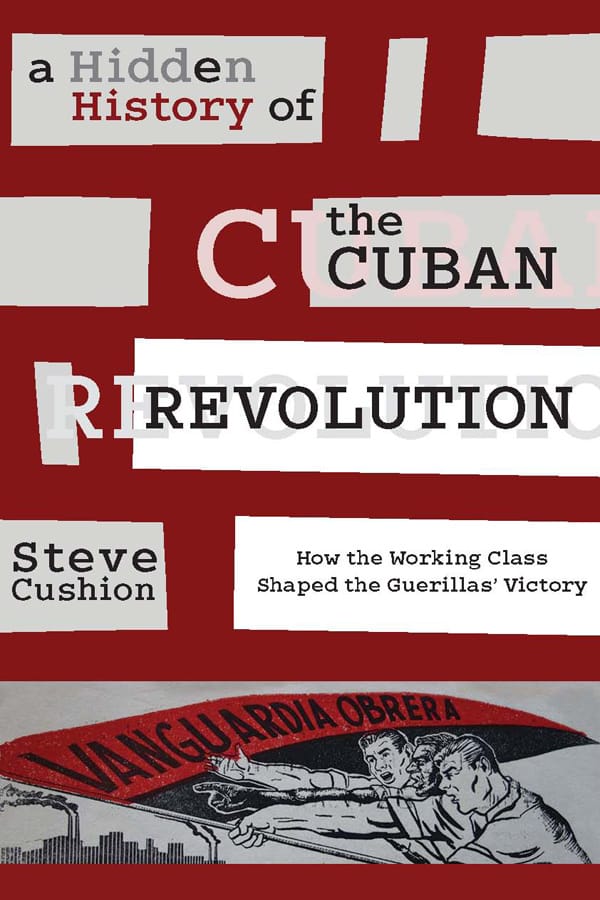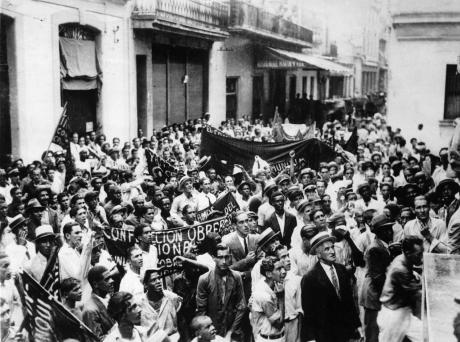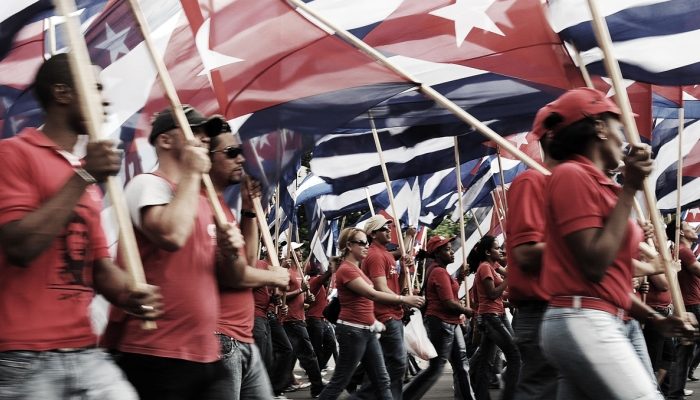A Hidden History of the Cuban Revolution: How the Working Class Shaped the Guerrilla’s Victory, Steve Cushion, 2016.
Book review by Andrew Martin

The Cuban Revolution was one of the most significant moments of the 20th century. Its impact on global politics continues to stir debate today. Seemingly out of nowhere, a small band of revolutionary guerrillas were able to forcibly seize power and overthrow a US-backed dictator, establishing a socialist government that achieved momentous social changes and controversially, formed ties with the Soviet Union.
The revolution completely reshaped Cuban society, nationalising the banking sector, oil and the landholdings of the notorious United Fruit Company. Agrarian reforms collectivised the ownership of what had been US-owned sugar plantations. Through mass democratic assemblies, the working class was able to participate in a nationally planned economy which laid the basis for the survival of the revolution, protecting it from both military and economic threats.
Through a mass voluntary movement of youth, illiteracy was eliminated and infant mortality became the lowest in the developing world. The revolution gave dignity to the descendants of Haitian slaves, eliminating segregation. Women entered the workforce and now hold the majority of technical and scientific positions within Cuban society.

Steve Cushion’s book is a valiant effort at uncovering the truth of the Cuban Revolution; that the working class were not only in favour of the Cuban Revolution but were active participants and protagonists in their own right. The actions of the working class in overthrowing Batista went much deeper than supporting a small band of guerrilla fighters in the Sierra Maestra. Cushion uncovers widespread militant activity either independently or in cooperation with Fidel Castro’s guerrilla army.
Cushion’s compelling record of events relies on extensive archival research and interviews with trade union militants. Through five research trips, Cushion is able to recount all the manifestations of working-class struggle, from illegal strikes of dockworkers, rail workers and cane-cutters, to acts of sabotage, armed conflicts, two revolutionary workers congresses and the largest general strike in Cuba’s history. Cushion points out that although the state apparatus was weakened by the guerrilla war, without the active participation of the working class, the Cuban Revolution could not have been successful.
This working-class support for the revolution was reflected in the consolidation of many social gains in the years that followed and the crushing of the “Bay of Pigs” invasion by US-backed militia. It’s unfortunate that it has taken so long for a systematic account of working-class struggle in Cuba to surface. As Cushion points out, all the archival evidence is there, retained by the Institute of Cuban History in Havana.
Cushion charts the militancy, organisation and unity of the working class throughout the turmoil of the 1950s. The capitalist class in Cuba were confronted with a major crisis with the collapse of sugar prices globally in the early 1950s. This had dire consequences for Cuba as sugar comprised 80% of exports with the whole economy revolving around this single cash crop. Cuba was producing 18% of the world’s sugar.
The tensions of the Cold War, heightened by the US war on Korea had led to stockpiling of sugar globally, leading to new plantations with more advanced methods of production being established around the world. The inevitable collapse in the price of sugar led the Cuban capitalist class to put restrictions on the amount of sugar harvested in an attempt to drive prices back up. This only reduced their market share and exacerbated the crisis they were facing.
Faced with a restive working class after years of political stability and a major economic crisis, the capitalist class gave their support to the Batista regime. The brutality of Batista’s police state would be aimed directly at the working class forcing them into the choice of submission or conflict.
One of the biggest barriers workers faced was the dominance of Eussibio Mujal over the main trade union confederation, the CTC (Conderación de Trabajadores de Cuba). Mujal had direct links to the dictatorship and eventually fled when it fell. The CTC was a major roadblock to the success of the Cuban Revolution. It was not simply undemocratic and bureaucratic – but ruthlessly controlled by the mafia.

The history of Cuban trade unions is as long as its struggle for independence from colonialism, dating back to the age of guilds and craft unions, but it was not until 1925 that the trade union movement formed a national confederation, CNOC (Conderación Nacional Obrera de Cuba). This was the same year, with much promise, that General Machado was elected.
The Great Depression of 1929 hit Cuba hard, with sugar exports plummeting. Machado relied more and more on military repression to enforce his rule. The country entered a period of tumult, political instability and corruption that continued through to the 1950s. Machado’s rule was overthrown by a brash young military officer, Fulgencio Batista.
Batista’s government in the 1930s provided some basic reforms legalising trade union’s that had been operating clandestinely. Under the influence of Moscow, the PSP (Partido Socialista Popular) called for a cross-class alliance during WW11.
Cuba was not immune to the Cold War. Although strong militant traditions had been built in the early part of the 20th century, these had started to erode. The socialist movement, based in the wharves, railways and sugar plantations, was very much marginalised and in retreat. Its leaders faced increasing persecution and demagogic attacks. They had been discredited by supporting a no-strikes policy during the war, leaving the trade union movement in disarray and the PSP politically isolated.
The 1947 congress of the CTC marked a shift in the politics of the labour movement. The trade union leaders associated with the Cuban Communist Party, the PSP, were ousted from office by an opportunist clique. Although pitching themselves as “practical”, seeking “workable solutions”, these leaders soon ingratiated themselves towards, first the government of Grau San Martin and then Batista’s dictatorship in 1952.
They were unable to resolve the tensions created by Cuba’s economic crisis – leading to a vacuum of leadership. Pre-revolutionary Cuba is often described as a place of prosperity. While it may have been a gangster’s paradise and its GDP may have increased due to more US investment, the reality for the Cuban working class was severe immiseration resulting from the collapse of sugar prices.
Cushion notes the importance of this juncture in Cuban history, “There is, therefore, a link between the fall in the price in sugar, the resulting crisis in profitability, and the employers need to increase productivity that provides an explanation for the 1952 military coup and the support given to the resulting dictatorship by business interests…if changes in the political economy of the island resulted in a deterioration of the working and living conditions of workers, then this will have a bearing on the form and degree of their involvement in the revolutionary process”.
These economic factors deepened the political divisions within society. The Cuban working class rejected the arguments from CTC leaders to accept increases in productivity and were embittered by mass layoffs and increasing workloads.
The blatant corruption of the CTC drew workers towards the PSP and the emerging July 26th Movement (M-26-7). Eventually, the two organisations would form links with one another and coordinate actions throughout the small island nation, particularly in the east where the rebel forces were stronger. This organisation spread to all the major urban centres. This impetus was pushed forward by objective necessity and the dynamic towards unity of the working class when they are propelled into struggle.
Cushion reveals that the working class developed not only strong levels of organisation, but also possessed a radical and advanced political consciousness. Not only were they able to overcome the hardships of struggle, but were capable of forming the correct tactical approaches to underground struggle and the mass work of creating an urban insurgency – they played a decisive role in the victory of the Cuban Revolution.
The book was clearly a labour of love for Cushion, is rich in detail and useful for pinpointing key moments in the development of working-class struggle in Cuba. What I found interesting was the relationship between the M-26-7 and the PSP since most historical accounts portray these two organisations as at odds with each other. Cushion brings to life the complex struggle of rank and file members of the PSP and M-26-7 to combat the Batista regime, suggesting that unity started with the working-class base of both organisations eventually coalescing in a united front that was formalised with the Frente Obrero Nacional Unido (FONU).
Cushion scoured through a mass collection of leaflets, pamphlets, clandestine newspapers and other agitational material from the 1950s as well as sourcing some statistics from dispatches from the US Embassy and US Department of Commerce. His systematic study, extensively indexed, gives the book genuine authenticity. The book does not present itself as a counter-position to the importance of guerrilla struggle in the defeat of Batista but enriches the understanding of the Cuban Revolution and tells the untold story of the Cuban working class.
Although there is a brief outline of struggle preceding the 1950’s, the book focusses mainly on the years 1952 to 1959. The focus is on the insurrectionary activity of the working class rather than the outcome of the revolution and the government that took power. It is not intended to be a complete analysis of the Cuban Revolution, but covers many important topics such as the role of the trade union bureaucracy, the wave of strikes in 1955, the lessons learned from defeats, dealing with state terror, the variegation of the working class and the relationship of militants with the M-7-26.
Underlining the central thesis of Cushion’s work is the historical account of workers congresses held within rebel territory, showing Castro’s forces always had an orientation towards the working class. Indeed, the future course of the revolution was fought within the ranks of the trade union movement eventually splitting the CTC away from the “Mujalista’s”. At the local level, the authority of the CTC was always contested, its power far from being monolithic. Without such a consolidation of working-class organisation, the Cuban Revolution could never have advanced and survived incursions and economic attacks from US imperialism.

It’s important to remember that the workers who led these struggles were not initially large in number. Neither did they all initially possess a revolutionary consciousness, but they learnt from the intensity of struggle that revolutionary action was the only way forward to liberation. They learned from their defeats, developed an extensive underground press and networks to support the guerrilla struggle. Many of them lost their lives in the course of the struggle.
Cuba faces many struggles today, not least a US embargo that has lasted over sixty years which continues to strangle Cuba’s development. Nevertheless, despite all the hardships Cuba remains an alternative and beacon of hope to the neo-colonial world. Behind its tropical charm lies a resilience and determination that refuses to be beaten. Cuba shows another world is possible.

[…] the left, including socialist organisations. They either do not understand the Cuban revolution, or deliberately obscure the role workers played in winning and maintaining revolutionary power. In misunderstanding the role workers played in their own self-emancipation, Cuba’s critics sully […]